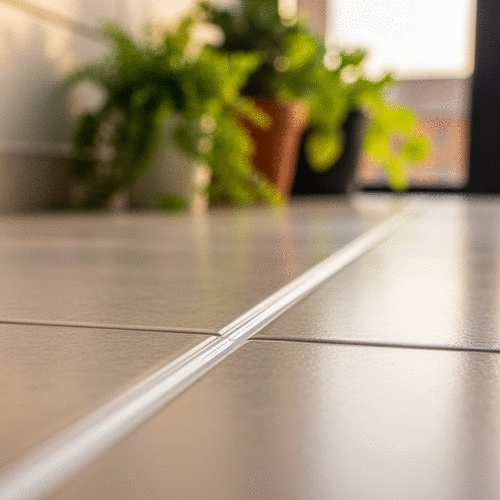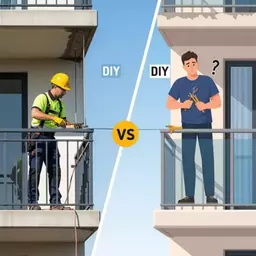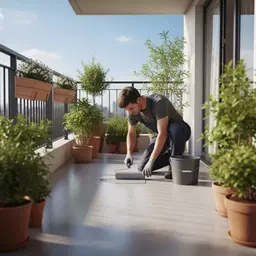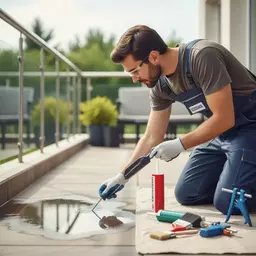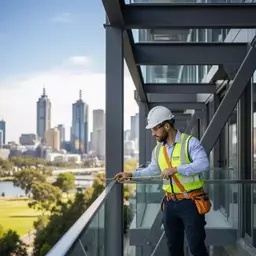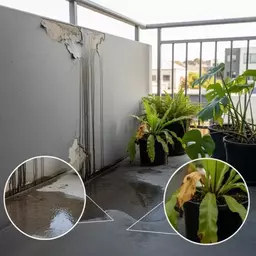Are you aware that neglecting your balcony's maintenance can lead to significant structural issues? Proper grout and sealant play a vital role in protecting your outdoor space, and understanding their importance can save you money down the line.
What You Will Learn
- Regular resealing prevents water damage and extends the lifespan of your balcony's surface.
- Understanding the roles of sealant and grout is critical for maintaining your balcony's structural integrity.
- Choosing sealants with UV protection and weather resistance can significantly reduce maintenance frequency.
- Identifying signs of wear, such as cracks or discoloration, allows for proactive maintenance and avoids costly repairs.
Balcony Maintenance: Key Areas for Longevity and Prevention
Understanding the critical aspects of balcony care, from essential components to early detection of issues, is vital for maintaining structural integrity and aesthetic appeal. This visual outlines why grout and sealant are crucial and what signs indicate a need for intervention. For more comprehensive insights into maintaining your outdoor areas, explore our balcony care tips for homeowners.
Why Balcony Resealing is Essential
- Prevents Water Damage
- Extends Lifespan of Surface
- Maintains Aesthetics & Property Value
*Recommended every few years
Grout & Sealant: Waterproofing Role
- Sealants prevent water seepage
- Grout provides structural support
- Flexible sealants reduce crack risk
*Critical for safety & durability
Key Deterioration Indicators
- Cracks in Grout
- Discoloration or Staining
- Peeling/Flaking Sealant
- Mold Growth
*Spotting signs early saves cost
Benefits of UV Protection & Weather Resistance
- Prevents fading & degradation
- Withstands extreme weather
- Reduces resealing frequency
*Safeguards investment
Understanding the Role of Grout and Sealant in Balcony Maintenance
When it comes to balcony maintenance, understanding the role of grout and sealant is crucial. These materials are not just for aesthetics; they play a significant part in protecting your balcony from water damage and ensuring its longevity. If you’ve ever noticed cracks or discoloration on your balcony, it may be time to reassess your sealant and grout situation!
Regular maintenance, including resealing, can save you from costly repairs down the road. In my years of experience with Balcony Repairs Melbourne, I’ve seen firsthand how proper care can extend the life of a balcony and enhance its overall appearance. So, let’s dive into why this process matters so much! You can also learn more about how to spot balcony leaks in homes to prevent further damage.
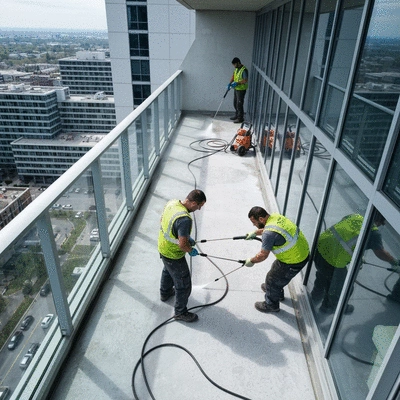
Why Regular Balcony Resealing Is Essential for Longevity
Many homeowners underestimate the importance of regular resealing. Resealing your balcony helps to maintain its structural integrity and prevents water infiltration that can lead to serious issues. Here are a few key reasons why you should consider making it a part of your maintenance routine:
- Prevents Water Damage: Sealants act as a barrier against moisture, protecting the underlying materials from rot and mold.
- Extends Lifespan: Regular resealing can significantly prolong the life of your balcony's surface.
- Maintains Aesthetics: A well-sealed balcony looks more appealing and can enhance the value of your property.
At Balcony Repairs Melbourne, we recommend scheduling resealing every few years, depending on exposure to the elements. This proactive approach can save you from unexpected repair costs in the future!
How Sealant and Grout Contribute to Waterproofing and Structural Integrity
Sealant and grout serve critical functions in waterproofing and maintaining your balcony's structural integrity. The right materials can ensure that your balcony remains safe and durable over time. Here’s how these components work together:
- Waterproofing: Sealants create a protective layer that prevents water from seeping into the underlying structure.
- Support: Grout fills gaps and provides support for tiles or other surfaces, helping to maintain a stable structure.
- Flexibility: Modern sealants are designed to expand and contract with temperature changes, reducing the risk of cracks.
By understanding these roles, you can make informed decisions about the materials you choose and how often you reseal your balcony. Remember, keeping your balcony watertight is essential for both safety and longevity!
The Importance of UV Protection and Weather Resistance in Sealants
Not all sealants are created equal! Choosing a sealant with adequate UV protection and weather resistance is vital, especially in a city like Melbourne where we experience diverse weather conditions. Here’s why these features are so important:
- UV Protection: Sealants that offer UV resistance will prevent fading and degradation caused by sunlight, keeping your balcony looking fresh for years.
- Weather Resistance: High-quality sealants can withstand rain, snow, and extreme temperatures, ensuring a long-lasting seal.
- Longevity: Sealants with these properties can dramatically reduce the frequency of resealing, saving you time and money.
By opting for high-quality products that provide UV protection and weather resistance, you can help safeguard your investment and enjoy your balcony without worry! For more details on protecting your balcony, consider reading about waterproofing solutions for Melbourne balconies.
Pro Tip
Did you know? Regularly cleaning your balcony before resealing can significantly enhance the effectiveness of sealants. Remove any debris, mold, or dirt to ensure a strong bond between the sealant and the surface, helping to extend the life of your balcony and prevent water damage!
Identifying Signs That Your Balcony Needs Maintenance
As a balcony owner, I can tell you that it's crucial to stay vigilant when it comes to the condition of your outdoor space. Identifying signs of wear and tear early can save you from costly repairs down the line. Whether it's a residential or commercial balcony, knowing what to look for can help you maintain its structural integrity and aesthetic appeal.
So, what should you be watching for? Here are some common indicators that your balcony may need immediate attention:
- Cracks in the Grout: Visible cracks can lead to water infiltration.
- Discoloration or Staining: This could indicate moisture damage.
- Peeling or Flaking Sealant: If sealant is losing its grip, water can enter.
- Mold Growth: This is a sign of prolonged moisture exposure.
- Creaking or Sagging: Structural issues can be serious and should not be ignored.
These signs can often be spotted during your routine balcony inspections. Make it a habit to check for any of these issues after severe weather or at regular intervals!

Common Indicators of Deterioration: Spotting Grout and Sealant Issues Early
Regular inspections are key to preserving the life of your balcony. When you spot problems early, you can avoid more extensive repairs in the future! Here are some specific signs to keep an eye out for:
- Cracked Grout: This can lead to moisture seeping in.
- Loose or Missing Sealant: Sealant acts as a barrier; if it’s compromised, so is your balcony.
- Moisture Puddles: Standing water is a clear sign that your drainage system might be failing.
By being proactive and keeping a watchful eye on these aspects, you can maintain a safe and attractive balcony space. If you notice any of these issues, it's time to act!
Assessing Damage from Water Infiltration and Mold Growth
Water damage can be sneaky. It often starts small but can escalate quickly if not addressed. Assessing the damage involves looking for signs of water infiltration and understanding how it affects your balcony’s structure. Here’s how you can assess the situation:
- Check for Stains: Look for water stains that could indicate leaks beneath the surface.
- Inspect for Mold: Mold doesn’t just look bad; it can impact your health!
- Evaluate Decking Material: If wood is rotting or metal is rusting, it’s a sign of serious water issues.
The earlier you assess and address these problems, the better off you’ll be. Trust me, as someone who specializes in balcony repairs, I can’t stress enough how important it is to catch these signs early!
Understanding the Role of Routine Inspections in Preventing Damage
Routine inspections aren't just for peace of mind; they're essential for preventing long-term damage. If you treat your balcony like a cherished part of your home, regular checks will ensure it stays in top condition. Here’s a quick checklist for your inspections:
- Look for signs of wear in both grout and sealant.
- Examine the balcony surface for cracks or flaking.
- Check drainage systems for blockages or issues.
- Assess the overall structural integrity.
By incorporating this simple maintenance routine, you'll not only extend the life of your balcony but also enhance its beauty and usability. Remember, a little effort goes a long way! For more detailed guidance, consider reviewing our seasonal guide to balcony inspections.
Recap of Key Points
Here is a quick recap of the important points discussed in the article:
- Regular Resealing: Schedule resealing every few years to prevent water damage and extend the lifespan of your balcony.
- Inspect for Damage: Look for cracks, discoloration, and peeling sealant to identify maintenance needs early.
- Choose Quality Materials: Use sealants with UV protection and weather resistance for long-lasting effectiveness.
- Routine Inspections: Conduct regular checks to maintain structural integrity and prevent costly repairs.
- Address Problems Promptly: Act quickly on signs of water infiltration and mold growth to protect your balcony.
Frequently Asked Questions (FAQs)
Why is regular balcony resealing important?
Regular resealing is crucial because it prevents water damage, extends the lifespan of your balcony's surface, and helps maintain its aesthetic appeal and property value. It acts as a barrier against moisture intrusion, protecting underlying materials from rot and mold.
What roles do grout and sealant play in balcony maintenance?
Grout provides structural support by filling gaps between tiles, while sealants create a protective, waterproof layer that prevents water from seeping into the balcony's structure. Flexible sealants also help reduce the risk of cracks due to temperature changes.
How often should I reseal my balcony?
It is generally recommended to reseal your balcony every few years. However, the exact frequency can depend on factors like exposure to the elements and the quality of the sealant used.
What are the benefits of using sealants with UV protection and weather resistance?
Sealants with UV protection prevent fading and degradation caused by sunlight, keeping your balcony looking new. Weather-resistant sealants can withstand rain, snow, and extreme temperatures, ensuring a long-lasting seal and reducing the frequency of resealing.
What are the common signs that my balcony needs maintenance?
Key indicators include cracks in the grout, discoloration or staining, peeling or flaking sealant, mold growth, and creaking or sagging. Spotting these signs early can prevent more extensive and costly repairs.

